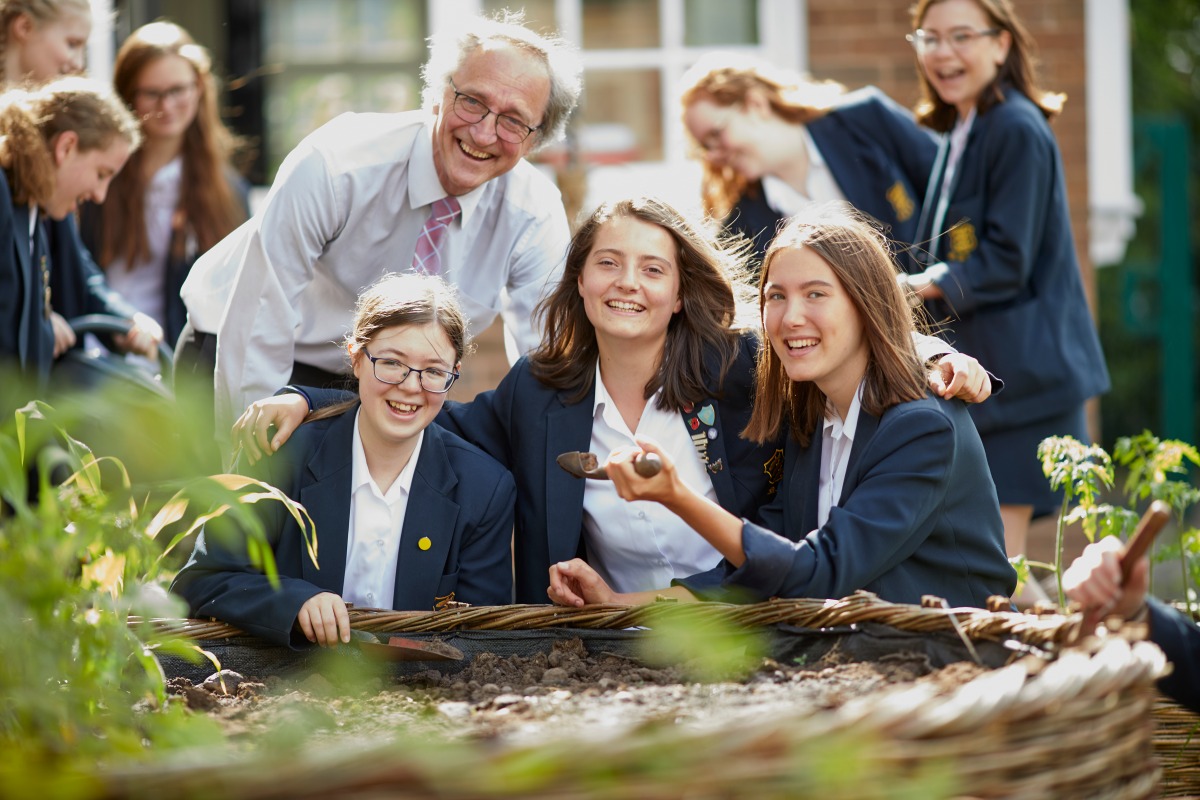I have been running, with the help from a few friends, a wildlife gardening club at my school for nearly two years, which is surprising to me. Not because that seems a long time, but because when you have to juggle exams, holidays and generally being a teenager, 2 years can really fly by.
I think it’s amazing how much we’ve achieved in this short space of time as a group and I’m hoping that through this blog I can inspire other students and teachers to start a gardening club in their school or community. It takes some determination but I believe everyone can take a few simple ideas and tools to start with, in our case a handful of trowels, and make a massive difference to the environment and more importantly, to the people involved. You can begin with just a few ideas, and a group of people who just want to spend more time outside, be more sustainable or simply enjoy nature. These people don’t have to be expert botanists, part of the fun is learning as you go and making mistakes, because it makes it even better when that plant finally flowers or you have your first harvest. Most of my friends were sceptical at the start before attending the club, and now (don’t be too surprised) they really enjoy it. They find it helps them de-stress, gain responsibility and they have great pride in the work they do and in seeing the benefits. They also, most importantly, have lots of fun and this is not only when we are digging and singing to the Backstreet Boys at the same time.
Ellie and the Gardening Club. Photo: Mark Waugh
I think the reason why I love running a wildlife gardening club at school is because I feel pride in the difference we’ve made to our school environment, but moreover because I can share my passion for nature and help inspire my fellow students to engage more with the natural world. Encouraging and expanding young people’s awareness of nature with the joy and importance of it is essential in safeguarding the future of conservation. Gardening club, I feel at least, is an amazing way to get students out the classroom and involved in learning, with friends, about plants and wildlife. I hope it ignites a passion for nature and teaches them skills that they can take forward in life. Hopefully they will be able to see the incredible inter-dependence between us, wildlife and our environment. In addition, as well as planting the seeds, if you can excuse the pun, for future conservationists, wildlife gardening itself is an act of conservation. As Alan Titchmarsh, TV gardening presenter and author, has said, gardening is a universal form of conservation we can all contribute to in our back gardens, by creating and sustaining habitats. This becomes even more important in urban areas, where gardening can allow each one of us to individually re-wild our own plot and provide a refuge for displaced and struggling wildlife. Gardening also is a perfect way to de-stress, retreat back to nature and to deal with any problems and worries, even if it’s just homework.
I think it’s amazing how much we’ve achieved in this short space of time as a group and I’m hoping that through this blog I can inspire other students and teachers to start a gardening club in their school or community
When deciding what to do in your gardening club, I’d suggest having a big vision but breaking it down into more realistic individual steps, to make it more manageable as you go. For example focus on one area to begin with to introduce yourselves - we started by re-planting some dilapidated raised beds with native and pollinator-friendly species; my favourites include buddleia, foxgloves, alliums, cosmos and ragged robin. Of course, you will need some funds to help you get started. To get things going you could run a non-uniform day or a jumble sale. Many supermarkets like Waitrose, Asda and banks such as Nationwide provide community funding which you can apply for. Through our mufti days, selling of produce, community funding and awards we’ve raised nearly £2000 in cash and assets for our club in the last two years alone. I also highly recommend the RHS School Gardening Levels as they provide great rewards as you achieve more within your group. At just Level 2 you can be awarded a set of Bulldog gardening tools and at Level 3 you could achieve a Rockets garden voucher worth one hundred and fifty pounds. These awards also give great guidance and targets for your school or community group to aim and aspire towards. The awards and support given by the RHS opens up a world of opportunities, as following my award with them we even had a visit to our school from TV presenter Frances Tophill, which I, all the members of Gardening Club and teachers were very excited about plus an array of woodland plants were donated by the RHS for planting around our willow dome on the day.
Wildlife gardening is a fun form of conservation. Photo: Mark Waugh
Other projects that we undertook which could be replicated include installing hanging baskets, planting trees, in our case twelve native fruit trees in an orchard, building/buying raised beds for a vegetable patch, a sensory area with herbs/ grasses and bug houses or bird boxes. Our most recent project has involved using Mr Wade’s skills, as he’s very kindly constructed a willow dome and tunnel, for a new and developing outside learning area with, fingers crossed, a pond. If I’m being honest ponds are one of, if not the most important features in a wildlife garden, just due to how much biodiversity they can support, by creating a new aquatic ecosystem. Now, it’s probably important to reiterate that you should take one project at a time, to ensure that they are always done to the best of your ability, and get completed.
I’ve learnt so much running this wildlife gardening club but what has been really inspirational and uplifting is to find that there are so many young people out there who care about the environment, genuinely wanting to contribute to its restoration and they acknowledge the importance of reducing plastic use, recycling and food miles. There is no Planet B, after all. We‘ve just welcomed the new members of Year 7 to Gardening Club and it’s really fulfilling to see how interested and engaged they are. One Year 7 pupil even suggested building a biogas generator, which is certainly ambitious but also highlights the understanding of young people today. However, what is disappointing is not everyone sees wildlife gardening as a way to help conservation and to mitigate against climate change - I really hope this changes.
I also highly recommend the RHS School Gardening Levels as they provide great rewards as you achieve more within your group. At just Level 2 you can be awarded a set of Bulldog gardening tools and at Level 3 you could achieve a Rockets garden voucher worth one hundred and fifty pounds.
Naturally there have been challenges especially around dispelling the negative stigma associated with young people and gardening. It’s been a lot of work to transform and enhance the space in so many ways, but we’re here to show that our generation do care and do want save our environment. Wildlife gardening is a fun form of conservation accessible to everyone and enhances our own mental health and productivity. Therefore, I really just want to say go for it because you won’t regret it and it’s your opportunity to make a positive impact on people, wildlife and the environment all in one. I love running the club and I wouldn’t change a thing.
Top tips
- Shrubs and trees are under-rated – they provide cover and form, especially in winter when there are less flowers and species like buddleia, honeysuckle, hebe and lavender can encourage pollinators
- Grow as much as you can from seed or cuttings, you can propagate more than you think. Not only is it cheaper (which is always good in my books) but it also uses less plastic pots and gives you lots more plants.
- Don’t be afraid to give try something new. Part of the fun is trying out new plants, projects, techniques etc - we tried microwavable chocolate beetroot mug cakes. They were awesome especially with marshmallowsJ
- Be brave: leave an area of the garden wilder, maybe not quite untouched but a space where the grass can grow longer and wildflowers can emerge.
- Try to include as many people as possible. In community projects the collaboration is more important than the end product - try to do this by giving out responsibility roles, like head photographer - a suggestion by founder of the Allotment Project Matt Willer.
- Sell and share produce you’ve grown with the teachers, students and the community to show how easy it is to grow and be healthier, while contributing to next year’s funding if you get donations.
- Use water features where you can as it will dramatically increase your garden’s biodiversity.



